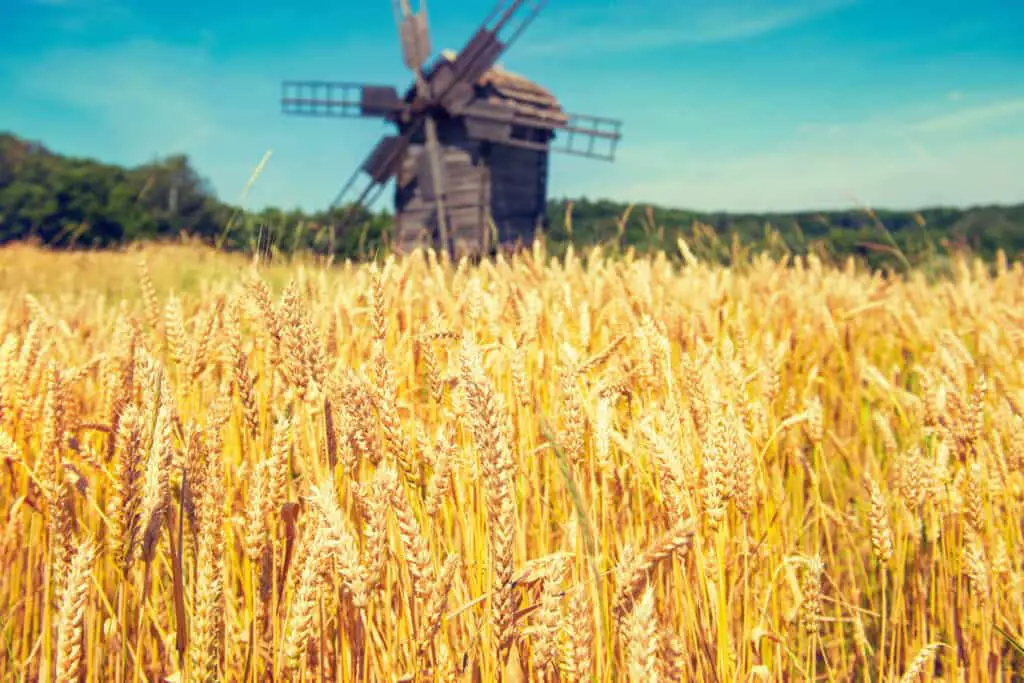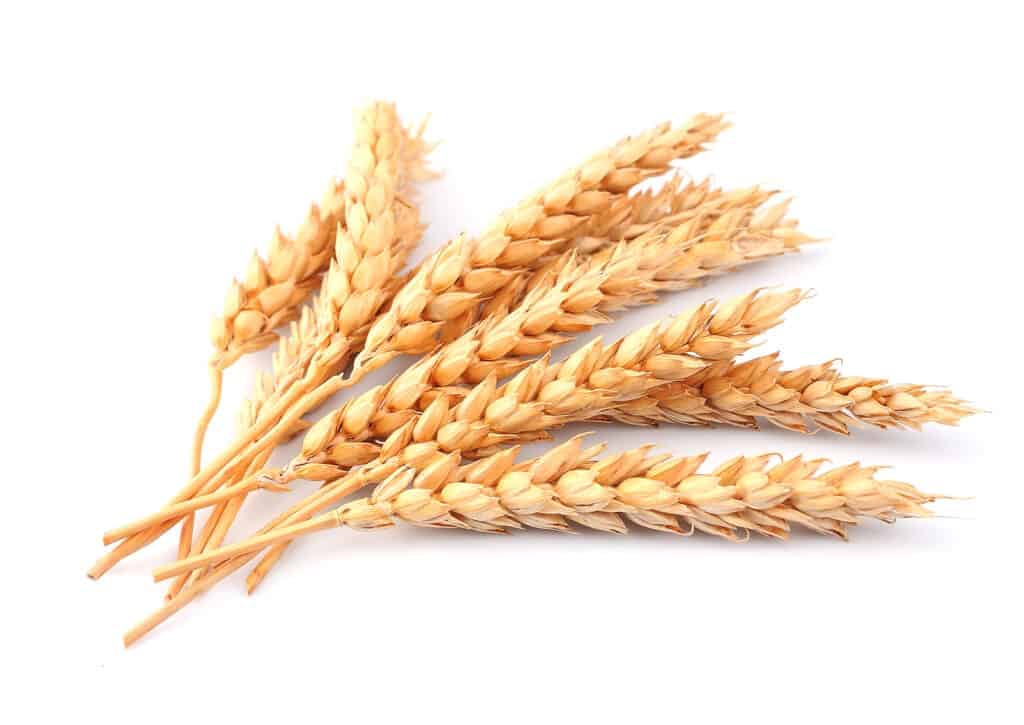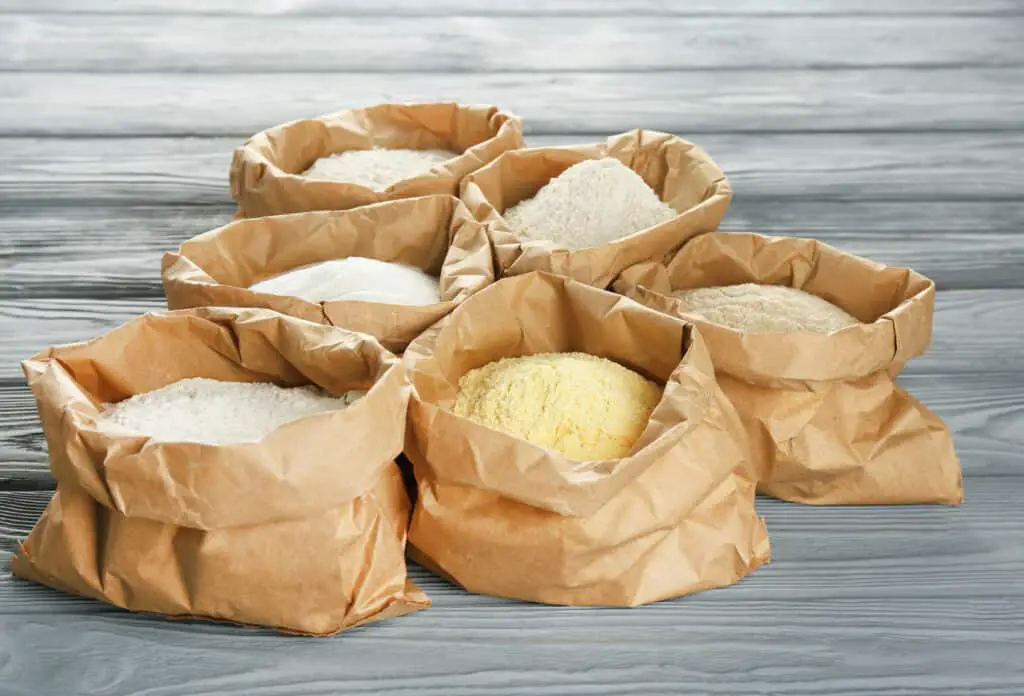What is All-Purpose Flour?
All-purpose flour is made from a combination of two types of wheat: hard and soft. It is sold both bleached and unbleached. Bleached all-purpose flour makes a softer texture in baked goods, while unbleached all-purpose flour creates a stronger structure in food. All-purpose flour is just that; all-purpose! You can bake almost anything using all-purpose flour including pizza dough, cookies, muffins, loaves of bread, biscuits, and so much more.
The wheat used to create all-purpose flour is usually either hard red wheat or a blend of two hard and soft kinds of wheat to make a good texture. If both hard and soft wheat is used, then the ratio of hard to soft is typically 80:20. All-purpose flour has a protein level of around 9% to 11%, depending on the brand of flour and the type of wheat used in the flour.
History of All-Purpose Flour
The first man-made tools that our ancient ancestors began to use date back to almost 250,000 years ago. Yet only 10 to 15 thousand years ago did those ancient humans begin to grind wheat into flour.
The purpose of milling, the process of separating the outer bran and germ from the inside part of the wheat, was to get to the softer endosperm of the wheat. Early humans most likely ate the endosperm of the wheat, but have since evolved their milling processes to get flour.

Flour has been used for centuries, since about 6000 BCE. The evidence was found in simple millstones with wheat seed crushed between them. Centuries later, the Romans began to grind down wheat seeds on cone mills, and later would become the first civilization to use water-powered mills around the year 100. Ancient Egyptians used saddle stones to grind wheat into flour. They would mix that flour with yeast found in a natural liquid to create bread.
Steam mills were introduced at the beginning of the Industrial Era in London, around 1779, which made the availability of high-grade flour increase. In 1845, Henry Jones patented what we know of today as all-purpose flour.
All-purpose flour was developed for the home baker, someone who needed a product that could be used in many different recipes without making the food or baked goods taste, look or cook any differently.

How is All-Purpose Flour Made?
All-purpose flour is made from wheat, so the first step is to grow the wheat. The wheat most commonly used for all-purpose flour is hard red wheat. Once the wheat is grown and harvested from the fields, it has to be milled.
Milling is the process of removing the endosperm out of the bran and germ. The milling style of today is very different from what the ancient humans and Romans were doing. Now, each grain of wheat is split open by a machine. Then, the components are separated and ground into a fine powder. This grinding process can happen up to 15 or 16 times to make sure that the flour is perfect.
Next, the flour is typically fortified. Nutrients like calcium, iron, niacin, and thiamin are added.
What Does All-Purpose Flour Taste Like?
All-purpose flour does not taste like anything. If you were to put a spoonful of all-purpose flour in your mouth, you would not be happy with the feeling. Unlike water, which has no taste, but tastes good somehow, all-purpose flour will coat your tongue and refuse to come off.
What Does All-Purpose Flour Smell Like?
All-purpose flour usually does not have a scent. Freshly ground flour may smell earthy or slightly like bread. Spoiled flour will smell a bit sour, musty, stale, or occasionally like play-doh or car tires.
If your all-purpose flour smells off in any way, it is best to just get rid of it and buy a new bag. It is not worth getting ill over the flour.
Why is All-Purpose Flour Different from Other Types of Flour?
Bread Flour vs All-Purpose Flour
All-purpose flour is usually different from bread flour in protein percentages. Bread flour usually has more protein than all-purpose flour at around 13%. This is because bread needs to have high levels of protein so that gluten is produced. Gluten is what gives bread that stretchy dough, chewy texture, and other characteristics.
Cake Flour and Pastry Flour vs All-Purpose Flour
All-purpose flour is different from cake flour or pastry flour in protein percentages too. Although, in cake flour or pastry flour, the percentage of protein is lower than all-purpose flour and bread flour. Low percentages of protein in cake and pastry flour give it a non-chewy, light, fluffy, and tender feeling once cooked. The protein percentage is around 9% for cake flour and 8% for pastry flour.
Self-Rising Flour vs All-Purpose Flour
Self-rising flour is all-purpose flour with a twist. Self-rising flour is all-purpose flour that has been blended with salt and baking soda. This type of flour is often used for baked goods that need to rise a bit but then relax in the oven. This means baked goods like biscuits, some cookies, and pancakes.
Vital Wheat Gluten vs All-Purpose Flour
Vital wheat gluten is a type of flour milled from the gluten collected from washing the wheat flour. Wheat flour is washed to remove the starch and clean the product. The gluten that is leftover from this process is dried out, ground up, and used as a strengthener in flours that lack gluten (like flour alternatives) or as a binding agent in other types of cooking.

Is All-Purpose Flour the Same Thing as “Plain Flour”?
All-purpose flour and plain flour are the same things. The only difference is their country of origin or sale. All-purpose flour is the common name in the United States of America. However, plain flour is the name used in places like the United Kingdom and Australia.
Neither all-purpose flour nor plain flour is a self-rising variety of flour. So you are safe to interchangeably use plain flour and all-purpose flour in your recipes.
It should be noted, however, that because these flours are milled in different countries, there is a good chance that they were milled from different types of wheat. This is not something to be concerned about. These small differences will usually only affect hardness and gluten content.
If you are concerned, you can compare the protein content of each brand of flour and then compare it to what your recipe calls for.
What Are Some Substitutes for All-Purpose Flour?
For folks who either have celiac disease, avoid gluten, or have other reasons for avoiding wheat flour, there are plenty of substitutes that can be used in most recipes to accommodate dietary restrictions. Dietary restrictions aside, some wheat flour substitutes are used because of their contribution to the flavor of the dish, bread, or baked goods.
Rye Flour
Rye flour comes from the cereal grain rye. It is cultivated in the Northern region of the United States of America, parts of Canada, Russia, and Eastern Europe. Rye flour and rye products are not completely gluten-free, but they average a gluten percentage of less than 2%, so many people who avoid gluten can eat rye flour products with no repercussions. This all depends on your body and situation, so please consult with a doctor before deciding that it’s fine for your body to handle.
Sometimes rye flour is blended with wheat flour to make the bread or baked goods a bit lighter and fluffier. Rye is often used in artisanal loaves of bread, typically fermented. Scandinavian flatbreads are made from rye flours.

Oat Flour
Oats have long been used as a grain and staple in human diets. Oat flour has an oaty, nutty taste and can be added to wheat flours to create yummy loaves. Oats and oat bran have long been connected to lower cholesterol and digestion regulation.
If you are looking to aid in lowering your cholesterol or helping to promote good gut and digestion health, try incorporating oat flour into your baked goods. Please make sure to clear this with your doctor if you believe this is a good plan for you.
Soy Flour
Soy flour is derived from soybeans, which are a great source of protein. The flour that comes from soybeans is very low in starch but very high in protein. It is also very low in gluten, so it is often added to bread, muffins, and other baked goods to increase the protein content of the food without affecting the texture or taste.
Soybeans are so high in protein that they are considered a complete protein for a human diet. Many protein bars, snacks, shakes, or other foods marketed as “protein” have soy flour in them to help promote good protein.
